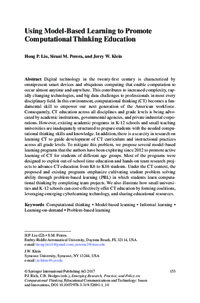Using Model-Based Learning to Promote Computational Thinking EducationHong P. Liu, Sirani M. Perera, Jerry W. Klein
Zu finden in: Emerging Research, Practice, and Policy on Computational Thinking (Seite 153 bis 172), 2017
  |
 |
 Diese Seite wurde seit 6 Jahren inhaltlich nicht mehr aktualisiert. Unter Umständen ist sie nicht mehr aktuell.
Diese Seite wurde seit 6 Jahren inhaltlich nicht mehr aktualisiert. Unter Umständen ist sie nicht mehr aktuell. Zusammenfassungen
Zusammenfassungen

Digital technology in the twenty-first century is characterized by omnipresent smart devices and ubiquitous computing that enable computation to occur almost anytime and anywhere. This contributes to increased complexity, rapidly changing technologies, and big data challenges to professionals in most every disciplinary field. In this environment, computational thinking (CT) becomes a fundamental skill to empower our next generation of the American workforce. Consequently, CT education across all disciplines and grade levels is being advocated by academic institutions, governmental agencies, and private industrial corporations. However, existing academic programs in K-12 schools and small teaching universities are inadequately structured to prepare students with the needed computational thinking skills and knowledge. In addition, there is a scarcity in research on learning CT to guide development of CT curriculum and instructional practices across all grade levels. To mitigate this problem, we propose several model-based learning programs that the authors have been exploring since 2012 to promote active learning of CT for students of different age groups. Most of the programs were designed to exploit out-of-school time education and hands-on team research projects to advance CT education from K6 to K16 students. Under the CT context, the proposed and existing programs emphasize cultivating student problem solving ability through problem-based learning (PBL) in which students learn computational thinking by completing team projects. We also illustrate how small universities and K-12 schools can cost-effectively offer CT education by forming coalitions, leveraging emerging cyberlearning technology, and sharing educational resources.
 Dieses Kapitel erwähnt ...
Dieses Kapitel erwähnt ...
 Anderswo finden
Anderswo finden
 Volltext dieses Dokuments
Volltext dieses Dokuments
 |  Using Model-Based Learning to Promote Computational Thinking Education: Artikel als Volltext bei Springerlink ( Using Model-Based Learning to Promote Computational Thinking Education: Artikel als Volltext bei Springerlink ( : :  , 377 kByte; , 377 kByte;  : :  ) ) |
 Anderswo suchen
Anderswo suchen 
 Beat und dieses Kapitel
Beat und dieses Kapitel
Beat hat Dieses Kapitel während seiner Zeit am Institut für Medien und Schule (IMS) ins Biblionetz aufgenommen. Er hat Dieses Kapitel einmalig erfasst und bisher nicht mehr bearbeitet. Beat besitzt kein physisches, aber ein digitales Exemplar. Eine digitale Version ist auf dem Internet verfügbar (s.o.). Aufgrund der wenigen Einträge im Biblionetz scheint er es nicht wirklich gelesen zu haben. Es gibt bisher auch nur wenige Objekte im Biblionetz, die dieses Werk zitieren.











 Biblionetz-History
Biblionetz-History